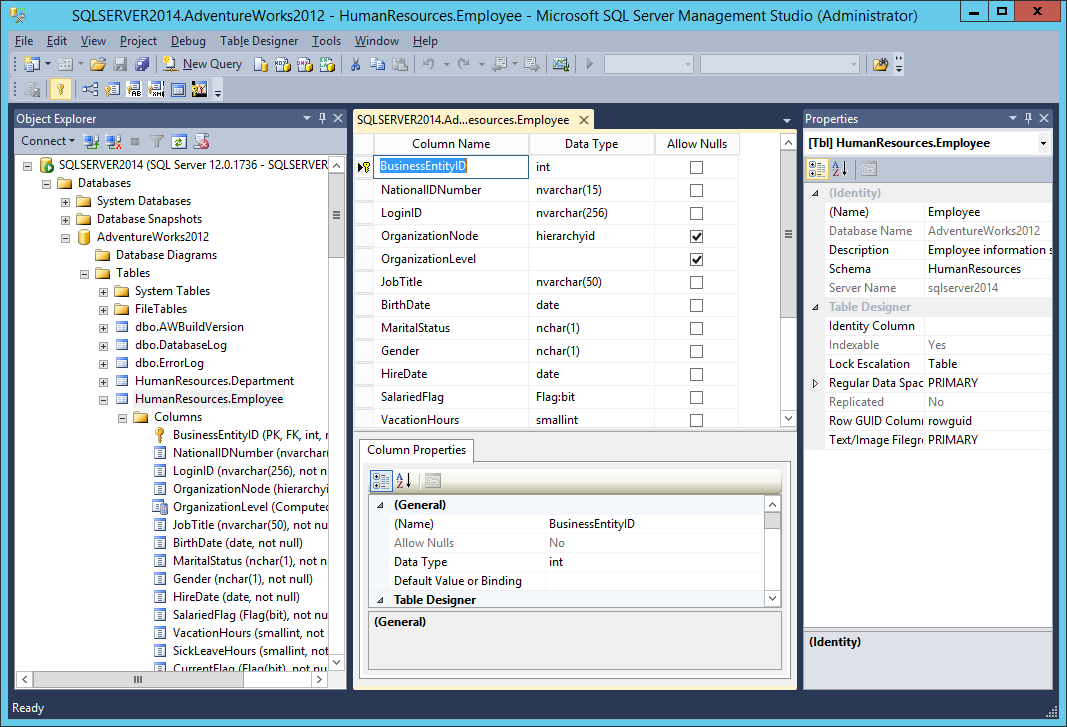
After that, the following window will open: When the extraction is completed, it’ll take a couple of seconds until the SQL Server 2014 setup processes the current operation. After choosing the directory click the Ok button and extraction will begin The window for choosing directory to which the extracted files will be saved is shown. Double-click on it to run the installation:
#SQL EXPRESS 2014 .EXE#
exe format with size of approximately 650 MB.
#SQL EXPRESS 2014 DOWNLOAD#
The current operating system will be specified under System type.Īfter selecting the desired file, click on the Next button in the bottom-right corner and the download will begin. If you aren’t sure which operating system type is installed on your machine, you can check it by right-clicking in My Computer >Properties. The bottom two files are MgmtStudio 32BIT\SQLManagementStudio_ x86_ENU.exe and MgmtStudio 64BIT\SQLManagementStudio_圆4 _ENU.exe and you should choose one of these according to the operating system running on the machine(32 or 64 bit), on which SQL Server Management Studio will be installed. The entire SQL Server Express edition can be downloaded from this link, however, for downloading only SQL Server 2014 M anagement S tudio, clicking the Download button will present a list of all files the complete installation is contained of, but you’ll need only one of these:
#SQL EXPRESS 2014 FREE#
SQL Server 2014 has a free edition – Express and while the server itself lacks some options that other editions have, SQL Server 2014 Management Studio is the same and can be used with each of these. We will examine each data type in detail in the next tutorials.There are multiple editions of SQL Server 2014 ( Enterprise Edition, Enterprise Core Edition, Business Intelligence Edition, Standard Edition, Web Edition, Express and Developer Edition). In this tutorial, you have learned about the brief overview of SQL Server data types. Store a result set temporarily for processing at a later time Store ellipsoidal (round-earth) data, such as GPS latitude and longitude coordinates. Represent data in a flat coordinate system. Store XML data in a column, or a variable of XML type Represent a tree position in a tree hierarchy The actual length of data entered + 2 bytesįor variables or stored procedure OUTPUT parameter that contains a reference to a cursorĮxpose automatically generated, unique binary numbers within a database. The binary data types stores fixed and variable length binary data. Unicode character string data types store either fixed-length (nchar) or variable-length (nvarchar) Unicode character data.
#SQL EXPRESS 2014 CODE#
The text data type can store non-Unicode data in the code page of the server. Character strings data typesĬharacter strings data types allow you to store either fixed-length (char) or variable-length data (varchar). In addition, the time, datetime2 and datetimeoffset have more seconds precision and datetimeoffset supports time zone. Because these types align with the SQL Standard and more portable. If you develop a new application, you should use the time, date, datetime2 and datetimeoffset data types. The date and time data types store data and time data, and the date time offset. They are often used in scientific calculations. The approximate numeric data type stores floating point numeric data.

The following table illustrates the characteristics of the exact numeric data types: Data Type The money and smallmoney data type store currency values.

Note that decimal and numeric are synonyms. The decimal and numeric data types store numbers that have fixed precision and scale.The int, bigint, smallint, and tinyint data types store integer data.The bit store one of three values 0, 1, and NULL.Exact numeric data typesĮxact numeric data types store exact numbers such as integer, decimal, or monetary amount. Therefore, you should avoid using these data types and use nvarchar(max), varchar(max), and varbinary(max) data types instead. Notice that SQL Server will remove ntext, text, and image data types in its future version. The following picture illustrates the SQL Server data types system: SQL Server provides a list of data types that define all types of data that you can use e.g., defining a column or declaring a variable. It can be an integer, character string, monetary, date and time, and so on. A data type is an attribute that specifies the type of data that these objects can store. In SQL Server, a column, variable, and parameter holds a value that associated with a type, or also known as a data type. Summary: in this tutorial, you will learn about SQL Server data types including numeric, character string, binary string, date & time, and other data types.


 0 kommentar(er)
0 kommentar(er)
